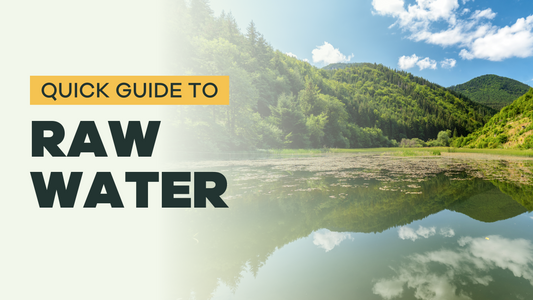
Simple Ways to Avoid Arsenic Exposure
Our blog is written by real experts— not AI. Each guide is carefully reviewed and updated based on the latest research. Plus, with no affiliate links, you can count on unbiased insights you can trust.
What Are the Major Sources of Arsenic in Everyday Life?
Arsenic has had a varied history as an element, including use as a murderous poison, skincare product, insecticide, and even as a color enhancer in fireworks. As recently as the 1920’s, "Arsenic Complexion Wafers" were advertised in the United States as a way to remove unflattering scars, freckles, pimples, and blemishes.
While it is no longer trendy to purposefully consume arsenic due its deleterious health effects, it remains a ubiquitous element in our environment and is regularly found in (hopefully) trace amounts in our food, air, and beverages.
In this piece, we will take a deep dive into:
- What is arsenic and where it comes from?
- What level of arsenic is considered dangerous?
- What foods, drinks, and products may increase your arsenic exposure?
- What are some easy steps you can take to reduce your arsenic exposure?
We primarily cover arsenic exposures outside of drinking water in this piece. Make sure to check out this Arsenic in Tap Water article if you are looking for more drinking water-related information on arsenic.
What Is Arsenic and Where Does it Come From?
A toxic metalloid, arsenic is a naturally occurring element found in the Earth's crust and is often brought to the surface through volcanic processes. It can be found throughout the environment, and is frequently used in industrial activities like the creation of alloys and the processing of glass, textiles, and ammunition.
The most common source of arsenic exposure is contaminated groundwater. However, food, air, cosmetics, and other personal care products can also put you at risk for arsenic exposure.
Arsenic exists in two forms: organic and inorganic. Organic arsenic is considered relatively nontoxic, whereas inorganic arsenic (such as arsenic III and arsenic V) is toxic.
Arsenic has no taste, smell, or color and even the tiniest of concentrations can impact your health.
How Much Arsenic is Dangerous?
While a few low-dose exposures to arsenic may seem minor on their own, they can add up. This begs the question: how much arsenic exposure puts you at risk? The Federal EPA set an MCL of 10 PPB for arsenic in drinking water, but a MCL goal (MCLG) of zero. This means that no amount of arsenic is considered safe.
The lethal dose of arsenic trioxide (a common form of arsenic) in an acute exposure incident is about 600 PPB. Acute exposure results in nausea, vomiting, diarrhea, fatigue, blood vessel damage, and nerve system damage. Such doses are extremely rare.
Elevated chronic exposure to arsenic can cause skin damage, cancer of the liver, bladder, kidney or lungs, and cardiovascular issues.
Which Foods and Drinks Have the Most Arsenic?
Arsenic bioaccumulates in animals and plants uptake arsenic from contaminated soil or water through their roots. Specific foods like rice, apples, and seafood tend to have higher levels of arsenic because they intake arsenic more efficiently than other plants and animals. Despite evidence of arsenic accumulation in crops, meat, and seafood, the Food and Drug Administration (FDA) has no enforceable arsenic regulation.
Arsenic in Rice
Rice has a bad rap when it comes to arsenic. A 2012 Consumer Reports investigation tested over 200 rice products (including cereals, rice cakes, crackers) and found detectable levels of arsenic in almost every product tested. While a key dietary staple for billions worldwide, rice readily absorbs arsenic–posing a substantial challenge in global efforts to minimize arsenic exposure.
Arsenic accumulates in the leaves of plants more than in grains, however humans consume far more rice by volume than leafy foods. Arsenic dissolves easily in water, thus water-flooded conditions needed to grow rice contribute to its high arsenic levels. Brown rice usually contains more arsenic than white rice because arsenic concentrates in the grain’s outer layer (which is removed from brown rice to make white rice).
A 2007 study found that rice grown in California and the southern United States (the two largest producers of rice in the U.S.) averaged 0.17 and 0.30 μg/g arsenic in rice, respectively. While the average American consumes 14 grams of rice per day, this obscures variability in rice consumption. Diets typical among Asian or Latinx households, individuals with Celiac's disease, and infants consume higher-than-average volumes of rice. The authors concluded that consuming above-average volumes of rice with just 0.10 μg/g inorganic arsenic in rice could exceed the equivalent of EPA’s arsenic water standard.
Arsenic in Apples, Grapes, and Their Juices
Like rice, apples, grapes, and pears can be contaminated with arsenic from soil. In the first half of the 20th century, lead arsenate was the most used pesticide in North American fruit orchards. Fruits average less arsenic than root and leafy vegetables because arsenic tends to concentrate in the roots and leaves of plants. Washing fruits and vegetables thoroughly can remove contaminated soils from surfaces and reduce arsenic exposure, however this will not reduce arsenic levels within the plant.
In 2013, the FDA lowered the action level (or advised value) for arsenic in apple juice from 23 PPB to 10 PPB–equal to the EPA’s Maximum Contaminant Level (MCL) for water. That same year, Consumer Reports tested 88 samples of apple, grape, and fruit blend juices and found that about 10% of the samples had levels above 10 PPB.
There is some speculation that high levels of arsenic in fruit juices poses a larger threat to children, who tend to drink more juice than adults.
Arsenic in Meat and Seafood
Although a relatively minimal source of exposure, arsenic can also be consumed through eating meat. Animals that consume arsenic-rich food or water can store arsenic in their tissues and blood (i.e. bioaccumulation), which then impacts humans.
Chickens and turkeys were once treated with arsenic-based drugs. Although these drugs contain organic (non-toxic) arsenic, the FDA stated that organic arsenic can transform into inorganic (toxic) arsenic. A 2016 study found that using arsenic-based drugs increases arsenic levels in chicken and turkey meat, but arsenic-based animal drugs were phased out in 2015. John Hopkins University researcher Dr. Keeve Nachman suggested that meat and animal products have “little to no arsenic”.
Seafood–especially from the ocean as opposed to freshwater–is one of the largest contributors to total (both organic and inorganic) arsenic exposure. Water-filtering shellfish (like oysters, mussels, and clams) tend to have higher total arsenic levels than other seafood.
Although seafood has relatively elevated levels of total arsenic compared to other foods, much of it is in its non-toxic organic form. Dartmouth University stated that most seafood “stores arsenic in its harmless form”, but suggests avoiding seafood from areas with fish advisories.
Smoking, Cosmetics, and Supplements: Other Sources of Arsenic
Cosmetics, unregulated supplements, and cigarettes may contain arsenic. Smoking exposes individuals to arsenic-containing tobacco, and can exacerbate arsenic-related health issues by damaging cells. A University of Chicago study found that moderate to high arsenic levels in tap water puts smokers at a much higher risk for cardiovascular disease.
An FDA study found that trace concentrations of arsenic in cosmetics do not pose a substantial risk to human health compared to other sources. The only current regulation on cosmetics is that FDA must ensure arsenic levels in color additives for make-up do not exceed 3 PPM.
While arsenic wafers consumption ended in the early 20th century, natural supplements (like vitamins, minerals, and herbs) can still have trace amounts of arsenic if they are made from ingredients that contain arsenic naturally.
How To Reduce Your Arsenic Exposure
Your level of exposure depends on dose, length of exposure, the way in which you are exposed, and a plethora of other factors. Completely eliminating your exposure to arsenic is virtually impossible, but the good news is that there are some concrete steps you can take to reduce arsenic in your life:
- Keep up to date with the FDA’s recommendations on certain food products that have a history of high levels of arsenic. (Currently, the FDA has only released certain advisory guidelines for food producers who potentially produce foods with high levels of arsenic).
- Eat a more varied diet to reduce exposure by a specific type of food.
- Do some research into the specific cosmetics and supplements that you use often. This might make all the difference if you use these products daily.
- Test your water. Groundwater is the most prominent source of arsenic and can go largely unnoticed since arsenic cannot be tasted, seen, or smelled!
- Testing is made simple with Tap Score. Arsenic testing is included in every Essential, Advanced and Extended water testing package whether for city water or groundwater.
Have more questions about arsenic? Take a look at these resources below for more information:
- Arsenic in Tap Water – A Quick Guide
- Arsenic and Water Treatment
- Healthy Soil: Arsenic and Your Plants
- Heavy Metals And Bioaccumulation: What You Need to Know
Have more questions? The Tap Score team of water quality engineers, treatment experts, and chemists are standing by to help. From testing your water to finding the right treatment solution, they are available to answer any questions by live chat or email.

Sources and References
▾Arsenic Pills and Lead Foundation: The History of Toxic Makeup
Arsenic and Human Health Effects: a Review
metalloid | Definition, Elements, & Facts
alloy | Definition, Properties, Examples, & Facts
How does your environment impact your health? | SimpleLab Tap Score
What is the difference between organic and inorganic arsenic?
Heavy Metals And Bioaccumulation: What You Need to Know
A Market Basket Survey of Inorganic Arsenic in Food
Arsenic Accumulation in Rice and Probable Mitigation Approaches: A Review
Arsenic In Your Food Investigated
Poultry Consumption and Arsenic Exposure in the US Population
Toxic Metals Superfund Research Program: Meat
Toxic Metals Superfund Research Program: Seafood
Cigarette smoking and arsenic exposure a deadly combination
Arsenic, Cadmium, Chromium, Cobalt, Lead, Mercury, and Nickel Content
What Is The Difference Between MCLG and MCL?
Arsenic in Food and Dietary Supplements
Study Finds Supplements Contain Contaminants
Independent Lab Water Testing For Home And Business
How to Treat Arsenic V in Water?







